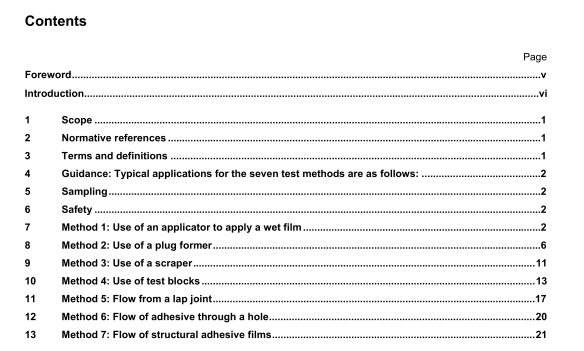ISO 14678 pdf download – Adhesives – – Determination of resistance to flow (sagging).
C) items of supplementary information given in 72;
d) result for each applicator gap depth;
e) that the method of test complied with the requirements of this standard, e. Method 1 or if it did not, the respects., wtiidi it did not coniply
f) any operating details not specified in the method, as well as any incidents likely to have affected the results, such as. for example, phase separation, etc;
g) date of the test.
8 Method 2: Use of a plug former
8.1 Principle
The adhesive is used to fl a cavity of known dimensions. The adhesive plug is then extruded and the apparatus is
placed vertically In the test atmosphere for the specified time and the degree of sagging measured.
8.2 Supplementary information
This method of test requires that the following supplementary rformation shall be specified etien the method is called up:
a) details of the test atmosphere:
b) details of the conditioning atmosphere,
C) temperature;
d) method of mixing of two-component adhesives and the trie between mixing and application;
e) duration of the test.
8.3 Apparatus and materials
8.3.1 Flow test apparatus. Bloci of metal, e.g. brass, light alloy or steel with a briil finish and overall dimensions not less than (100 50)mm.
The upper part of the block is driled to provide a c)Iindrical cavity of diameter (38 ± 0.05) mm. The adhesive plug is extruded from the cavity by a solid plunger closely fifing the cavity and provided with means of positioning the face of the plunger flush with the face of the block and at a depth of (9,5 ± 0.05) mm. A graduated scale shall be marked or engraved on the lower face of the block. The first line shall be tangential to the lowest point of the crcumference of the cavity and subsequent lines shall be spaced at (1 ± 0,1) mm or (2 ± 0.1) mm intervals over a distance of 50 mm. A suitable design Is shown In Figure 3 with end plates fitted to support the block during filling.
10.2.7 Spatula
10.2.8 Test panels, 150 mm long and approximately 50 mm wide, as specified. For test panels made of steel sheet. In the absence of any other Indication, use either a zinc electroplated steel sheet degreased and re-greased in accordance with EN 13887 or steel sheet coated with electrodeposited paint by the cationic method (for example, CORONA ED 3002 type) and stoved for 17 mm at 200 C.
10,3 CondItioning and pretreatment
Condition the product in the enclosure (10.2.1) for 16 h
Procedure A: lion’iogenize the product, using the spatula (10,2.7). immediately before taking the test portion.
Procedure B’ Take the product directly from the storage container.
NOTE 1 For products neoessotating a mixture of several cononents, this is effected with a spatula for one mmute and the test should be started 5 mm after starting to mix.
NOTE 2 The choice of procedure A or B and of sampling conditions should be given in the manufac*ure?s tectnicai data sheet
10.4 Procedure
Carry out the test in the conditioned enclosure (10.2.1).
Adjust the graduation of the block-preparation devoe (10,2.5) to obtain the desired block thickness, usually 4 mm.
Turn the equipment upside down and place a washer (10.2.4) at the bottom of the cavity formed by the withdrawal of the piston.
Fl the cavity to the rim with the product to be tested taking care to keep the body of the syringe in contact with the lower platen.
In a period of time less than or equal to 15 mm, place the equipment at one end of a test panel (10.2.8) located on a honzontal surface.
Raise the synnge body until It contacts the flange round the piston, raise It further In order to lift the piston slightly, so that the block is deposited onto the test panel.
Remove the equipment (10.2.5).
Mark the initial position of the edge of the block as shown in Figure 8.
(30 t 2)s after depositing the block, place the test panel and block on the mounting (10.2.3) m the enclosure set at
(23 * 2) C so that the block is on the sloping plane. Ensure that the mounting has already been brought to the
temperature of the enclosure.
Leave the test panel and block in This position for 30 mm.
Mark the new position of the edge of the block as shown in Figure 8.
Place the mounting, and the test panel and block in the oven (10.2.2) at the temperature and for the time specified.
Remove the test panel and block from the oven and mark the position of the edge of the block as shown in Figure
Measure with the ruler (10.2.6) lengths Land L (see Figure 8) in millimetres.
ISO 14678 pdf download – Adhesives – – Determination of resistance to flow (sagging)
